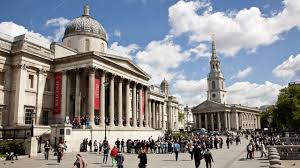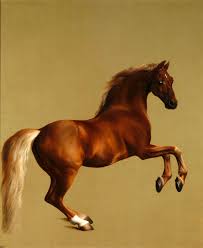
Whistlejacket-Stubbs at the National Gallery
On a warm spring day last year, me and my friend were walking around the National Gallery. On the rare occasions when this happens, I find it to be very relaxing and gratifying as we usually have a purpose for our visits and endeavour to take in as many of the sights that London has to offer.

The foremost reason for this specific outing was so that I could view the galleries Egyptian artefacts; which I have previously discussed in a recent article. The first part of the morning was spent viewing the antiquities and I was surprised at the amount of objects on show.
There appeared to be a lot of fuss centred around a painting as we entered one of the art galleries. We both presumed that there must be something important to view, so we headed in that direction. It was Van Gogh’s ‘Sunflowers’. Sometimes I find it difficult to visualise a work of art; mainly because it tends to be viewed either in books or on the television. When you finally encounter the original, it kind of takes your breath away. I stood there for a little while taking in the atmosphere and realised it was far bigger than I imagined and definitely worth the wait.
We continued walking around the art galleries, and then the most beautiful painting I have ever seen stopped me in my tracks. The size was impressive enough, but the impact it had was so significant it seemed to eliminate everything around it. I was spellbound. The painting in question was called ‘Whistlejacket’ by Stubbs.
I felt the need to discover as much as I could about this artist and the reasons why he painted this lovely horse called ‘Whistlejacket’. Why did he paint it and how did he paint it?
George Stubbs
George Stubbs (25 August 1724 – 10 July 1806) was born in Liverpool and was a self taught artist. He worked as a portrait painter in the 1740s, with the addition of studying human anatomy at York County Hospital. This prompted him to then spend the next 18 months dissecting horses, which in turn enabled him to produce and have published his book ‘The anatomy of the Horse’. His career continued with many commissions for paintings from aristocrats and dukes, which in turn secured his future to continue with his craft.
Stubbs’ painting of a kangaroo, was the first time the 18th century british public had observed an animal of this type. He was therefore highly influential.
The 2nd Marquess of Rockingham commissioned the painting of his racehorse ‘Whistlejacket’ at the end of its career. Stubbs painted the horse with oil on canvas and highlighted many of the animal’s finer features to create a dramatic piece of work. It was unusual in that there was no other subject within the painting, only the prancing horse with its striking features. Two more paintings followed in the same vein, having plain backgrounds.
Following this, during the mid- 1760s, he produced many portraits of horses, individually or in groups, sometimes with hounds and other wild animals. It is interesting to note that artists can take in their surroundings before they begin to paint a landscape or a seascape, for example, in order to get a feel for the atmosphere, which will then in turn, reflect in their brushstrokes. Stubbs, with his foremost knowledge of the anatomy of the horse, aided him in his acutely descriptive renderings of the form and structure of the animal.
I think his work is captivating.


One Comment
Pip
Thank you for your message Bella. There’s just something he captured in the horse’s expression, the look of the eye that’s so captivating. It’s so clever isn’t it. I feel a visit is on the cards for me soon too x